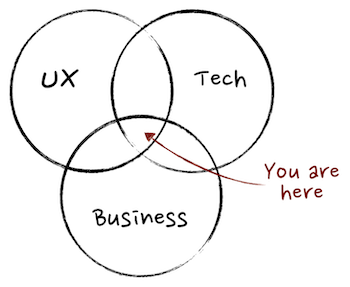The product manager plays a crucial leadership role in developing a company’s products. Their job, broadly speaking, is to envision products that delight customers while simultaneously increasing revenue. It sounds simple, but there’s a lot of effort and coordination involved to turn an idea into a functional product.

The responsibilities of the product manager vary depending on the company and product. As a result, the product manager’s role is hard to define. Regardless of where or on what a product manager works, though, a multifaceted skill set is required to fulfill their tasks and ship the best possible product in a timely manner.
In this guide, we’ll do our best to pin down the product manager’s role and responsibilities and list the skills required to perform those tasks. We’ll also distinguish between product manager and product owner and outline some general tips and best practices to help PMs strive for success in their careers.
Product management luminary Martin Eriksson famously described the product manager’s role as seated at the intersection of business, technology, and user experience.

The product manager identifies customer need in the context of the product vision and business goals and oversees a development process designed to ship an optimal product as efficiently as possible. While the product manager’s specific responsibilities vary depending on the industry, the core responsibilities center around creating a product that resonates with customers.
The product manager usually serves a cross-functional role. They coordinate with several teams, including design, engineering, and executives, to create and maintain a product suite.
A product manager has two long-term responsibilities:
In general, a product manager’s responsibilities fall into four categories:
Products are designed to solve problems for users. To uncover these problems, product managers must develop an intimate understanding of their customers, market trends, and competitors.
The product manager role involves conducting extensive research to create a high-performing product that customers want to use.
After determining what product or feature needs to be built, the product manager can focus on create a product strategy. This strategy contains the product vision and the goals and objectives for executing that vision.
Additionally, product managers will build product roadmaps to visually demonstrate the expected timeline of releases. They also delegate responsibilities and milestones to respective teams. A product roadmap ensures all stakeholders are aware of what to expect.
Product managers don’t actually build the product themselves. Instead, they work closely with cross-functional teams to ensure the delivery of a product roadmap. These teams include business analysts, designers, and developers.
Building and maintaining relationships with cross-functional teams is a crucial part of product management. A good relationship establishes trust and open communication. A product manager will need both of these relationship traits to successfully execute a product strategy.
Development teams often encounter roadblocks, such as budget issues and release delays, when building products and features. Product managers are responsible for identifying risks, issues, and problems to minimize the impact of these obstacles. Then they can propose mitigation plans to overcome them using their established relationships and communication skills.
The product manager is also in charge of collecting feedback from users about what they like or dislike about the product suite. Identifying gaps between the product and a user’s problem can lead the way to the next product release.
Product managers may create a process to receive ideas from customers and company teams. Often, a company’s employees are aware of problems that customers are facing, and they may have ideas about how to handle those problems.
Product managers are responsible for a variety of tasks throughout the development process. As such, to build a successful career in product management requires a wide range of skills.
Below are just a few of the key competencies required to be an effective product manager.
Excellent communication skills, both written and verbal, are crucial for a product manager. Without clear communication, product managers will have difficulty building relationships and getting all stakeholders to support their vision and strategy.
A PM should know how to effectively communicate with many different roles, including customers, executives, and internal teams.
Product managers frequently have to present their plans and ideas to various stakeholders, which calls for strong storytelling and presentation skills. A product manager needs to be able to define a plan, explain why it is needed, clearly communicate the strategy, and win the audience’s enthusiasm about it. Presentation skills are closely related to the ability to communicate effectively.
Product managers are not the people writing the code to create a software product, but they do need to understand the principles. This will aid communication with developers and engineers about their projects and tasks. Technical skills also make it easier for PMs to understand what their engineers need to succeed.
Product management influencer and author Josh Fechter listed data analysis, SQL, A/B testing, and basic coding as technical skills worth adding to the product manager’s tool belt.
A general understanding of business operations helps product managers make better decisions. For example, knowledge of financial information such as pricing, revenue, and costs is crucial when deciding what features to build into your product. Companies are looking for a return on investment (ROI), and product managers need to know how to translate high-quality, efficiently developed products into revenue.
Product managers make a lot of decisions. Companies often look for product managers that can quickly analyze a situation and efficiently make a decision.
A product manager should have the ability to eloquently defend their decisions with logic and data to support why it was the best choice. Naturally, problem-solving and analytical skills don’t hurt, either.
As in most walks of life, empathy can go a long way in the product management profession. More often than not, customers don’t have a designated representative to advocate for them and convey their needs directly to the company.
The product manager needs to consider the interests of the customer at every step in the development process. An empathetic sensibility enables PMs to engage with customers about their problems and gain an intimate understanding of how a product could help solve those pain points.
Depending on how small or large a company is, a product manager may lead other product managers or work independently. Regardless of the size of the organization, it’s the product manager’s job to ensure all internal teams are working well together. A great product manager leads by influence rather than direct authority.
Research is the backbone of building a successful product. The product manager should have the skills to conduct research, analyze various data points, and craft a product vision based on that analysis. This may include quantitative and qualitative data, market trends, and competitor research. All of this research and analysis is necessary to build a product that addresses customer needs while also generating ROI.
It should come as no surprise that successful product managers have a demonstrated ability to multitask and manage priorities. It takes considerable coordination to launch products, add new features, and even maintain products. Product managers have effective planning and execution skills to help the team execute the product roadmap and vision.
The product manager and product owner titles are not interchangeable. In most organizations, the product manager oversees the execution of a broad vision while the product owner focuses on more granular, day-to-day operations, such as the product backlog.
The roles are defined differently within each organization, and there can be overlaps in responsibilities. Companies that have both a product manager and a product owner should clearly define responsibilities and expectations to prevent misalignment.
The table below provides a general overview of the responsibilities associated with the product manager and product owner roles at a typical organization.
| Product manager | Product owner |
|---|---|
| Creates the product vision and roadmap | Helps ensure product roadmap is executed |
| Works with outside stakeholders like investors | Works with customers and internal teams |
| Is responsible for the whole product lifecycle on a conceptual level | Is responsible for the product backlog and fulfillment work on a day-to-day basis |
| Has a deep understanding of customers, market trends, and competitors | Has a deep understanding of customers to create user stories and advocate for their needs |
The product manager and product owners usually work together to remove obstacles and execute the product roadmap with minimal hiccups.
Product managers are in demand in a variety of industries, including but not limited to banking, healthcare, software-as-a-service (SaaS), and more.
No matter which industry or what size company you work for, the following best practices and tips will help set you up for success in your product management career:
There’s no point in building a product if no one wants it. A product manager should meet their audience and get to know customers’ desires and pain points. This will help them build aligned products.
Product managers should make a point to build a relationship with their team. These are the people doing the actual work to build the product, and it’s crucial to get along with them.
As mentioned previously, product managers need good decision-making skills, and they often need to make choices quickly. The key to making fast and good decisions is knowing your product strategy. With this knowledge, you can prioritize what is important and how to resolve issues.
There is more to product management than just building and releasing products. Once it’s published, it’s the product manager’s job to monitor and analyze how people are using the product. You may detect issues with the product experience that affect your conversion rate. By fixing these problems, you could increase product usage and have happier customers and stakeholders.
Creating a valuable product is a rewarding experience for product managers. If you implement the best practices outlined above, you’ll have a unique opportunity to shape your company and how it contributes to the world.

LogRocket identifies friction points in the user experience so you can make informed decisions about product and design changes that must happen to hit your goals.
With LogRocket, you can understand the scope of the issues affecting your product and prioritize the changes that need to be made. LogRocket simplifies workflows by allowing Engineering, Product, UX, and Design teams to work from the same data as you, eliminating any confusion about what needs to be done.
Get your teams on the same page — try LogRocket today.

Most teams fail at autonomy. Learn how clear rules help product teams move faster without micromanagement.

A practical framework for PMs to use AI in ideation without sacrificing judgment, strategy, or decision quality.

A practical five minute revenue estimation method to help product managers compare ideas, drop low impact features, and prioritize smarter.

A practical guide for PMs who want to stop being bottlenecks, delegate smarter, and lead teams effectively with a clear ownership framework.